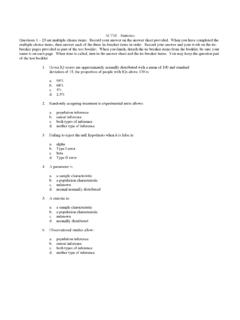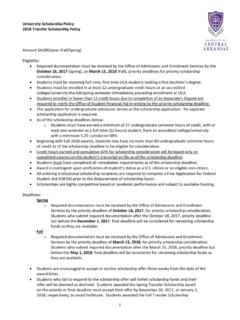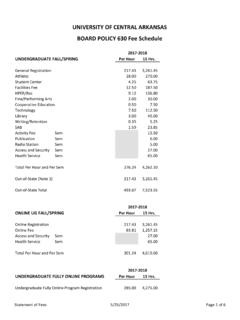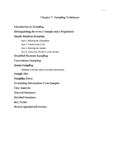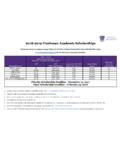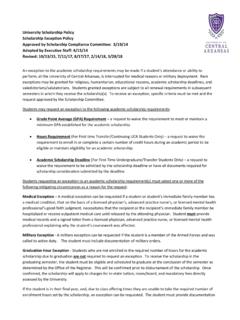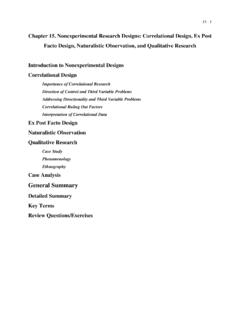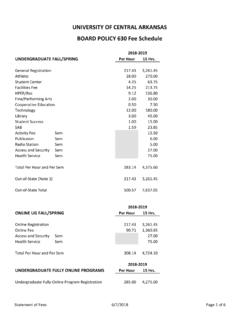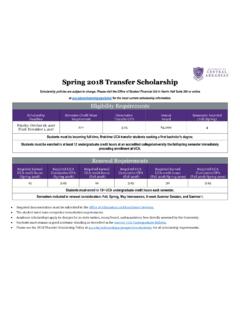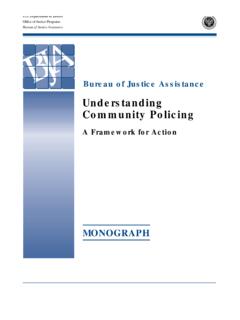Transcription of Cooperative Learning Activities - UCA
1 Cooperative Learning . GROUP Activities FOR. COLLEGE COURSES. A GUIDE FOR INSTRUCTORS. Prepared by Alice Macpherson Kwantlen University College Abstract Cooperative Learning Group Activities for College Courses Cooperative Learning Group Activities for College Courses is a compilation of Cooperative Learning Activities suitable for use in college level courses. The book is composed of six major sections. The first section is a foreword on how to use this guide. Section two is a brief overview of the elements of Cooperative Learning and how they can be applied. The next two sections are organizational Activities for instructors and preparatory Activities for participants prior to using the fifth, main section, containing over 100 customizable activity structures for a variety of objectives and Learning outcomes. It includes a template for developing Cooperative Learning Activities , as well as sample group Activities for: climate setting, group function, accountability, knowledge and comprehension, application, analysis, synthesis and evaluation, interaction and practise, reflection, Activities to complement projects, Activities to acquire feedback, and Activities to end a course.
2 The final section has questions for debriefing both group and idea processing. This material is intended to assist instructors to design and apply effective Cooperative Learning Activities over a variety of disciplines. All copyright is retained. 2000 2007. ii Cooperative Learning GROUP Activities FOR COLLEGE. COURSES A GUIDE FOR INSTRUCTORS. Table of Contents Abstract ..ii Foreword ..ix Elements of Cooperative 1. Goal Structure Definitions .. 2. Basic Elements of Cooperative Learning .. 3. Difference between Small Groups and Cooperative Learning .. 4. Why Use Cooperative Learning ? .. 5. How do Cooperative Teams Work?.. 6. Tuckman's Team Development Model .. 8. Stages of Team 9. What are the Types of Cooperative Learning Groups?.. 10. What does Research on Cooperative Learning Say? .. 13. How Do We Instruct Cooperative Team Skills? .. 15. Organizational Activities 17. Preparatory Activities 18.
3 Activity 19. Template for Cooperative Learning Activities .. 20. Group Activities for Climate Setting and Group 21. Icebreaker Find Someone Who .. 22. Three Part, Four Step Interview .. 23. Teambuilder Treasure 24. Develop Communication 27. Develop and Share Personal Goals .. 29. Form Support 30. Trust Building .. 31. Form Formal Groups .. 33. Goal Setting .. 34. Group 35. Share Experiences and Feelings .. 36. iii Classbuilder Wanted Poster .. 37. Classbuilder Matching Icons .. 39. Group 41. Group Activities for Group 43. Constructive Communication Strategies .. 44. I 45. Feedback Basics .. 47. 49. Active Listening 50. Active Listening II .. 52. Active Listening 54. Perception 55. Quality Team Assessment .. 58. Team Quality Chart .. 59. Negotiating Compromise .. 60. Activities to Promote Accountability .. 61. Numbered Heads 62. Terror Cards .. 63. Develop and Implement a Coaching Plan.
4 64. Group Activities for Knowledge and Comprehension .. 67. 68. Search-Pair-Share .. 69. Pair Read .. 70. 71. Nightmare Cards .. 74. Define Categories from Experiences .. 75. Flash Cards .. 76. 77. Follow a 78. Trace a 79. Pair Review Form Completion .. 80. Discussion Small Group Knowledge .. 81. Discussion Small Group Comprehension .. 82. Discussion Small Group Factors to be 83. iv Pair Review Note Taking .. 84. Formulate a Report .. 85. Prepare 86. Group Activities for 87. Read Maps / 88. Prepare a Block 89. Create a Flow Chart .. 90. Personal Planning .. 91. Solve 92. Create a Classification 93. Propose Situations .. 94. Develop 95. Develop 96. Create Scenarios .. 97. Operate Equipment (I) .. 98. Discussion Small Group Application .. 100. Group Activities for 101. Brainstorm Plus .. 102. Pass a Problem .. 103. Compare Systems .. 105. Differentiate Situations .. 106. 107. Analyze 108.
5 Analyze Video .. 109. Develop a Personal 110. Present 111. Operate Equipment (II) .. 112. Discussion Small Group 113. Analyze Ways to 114. Develop a Graphic Representation .. 115. Graph a 116. Group Activities for Synthesis and 119. Assess and 120. Compare Situations .. 122. v Compare Supports and Limits .. 123. Compare Systems .. 124. Compare Processes .. 125. Conduct an 126. Develop a 127. Develop a Case Study .. 128. Link Characteristics .. 129. Expand on 130. Develop an Analogy .. 131. Identify 132. Identify Issues .. 133. Pair Contrast for Differences .. 134. Analyze 135. Analyze Case 136. Develop Strategies using Case Studies .. 137. Prioritize 138. List / Refer / 139. Structured Academic Controversy .. 140. Discussion Small Group Synthesis .. 141. Discussion Small Group 142. Group Activities for Interaction and 143. Dialogue .. 144. Interact with a Guest Speaker .. 145. Interactive 146.
6 Interactive Practise Call 148. Group Activities for 151. Reflective Practise 152. Reflective Practise Questions or Situations .. 154. Reflective Practise Response to Change .. 155. Reflective Practise Identify Personal Bias .. 156. Reflective Practise Effect of Assumptions .. 157. Group Activities to Complement Projects .. 158. Set Criteria Project or 159. Report on Field Trips .. 161. vi Use a Model for 162. Use Resource 163. Research 164. 165. Make Referrals .. 166. Review an 167. Develop Interview Questions .. 168. Develop a 170. Exercise a Plan .. 171. Make a 172. Group Activities to Acquire Feedback .. 175. Identify Key Points .. 176. Classroom Research .. 177. One Minute Paper .. 178. 179. RSQC2 .. 180. Group Activities to End a Course .. 181. Write Course Questions .. 182. Write a Legacy Letter .. 183. Exchange Success Tips .. 184. Debriefing for Group Processing .. 185. Debriefing for Idea Processing.
7 188. List of 190. Cooperative Learning Internet Based Resources .. 192. Index .. 193. vii Foreword How to Use this Guide The purpose of this guide is to support instructors in enabling learners to effectively assimilate and apply curriculum material to meet the Learning objectives. It is intended for the instructor who has experience and skill in conducting group Learning and who is a current content expert in the subject matter. The first chapter includes an introduction to Cooperative Learning but should not be considered in depth. Individual training and study is also recommended to supplement this book. A commitment to lifelong Learning and change is important because of the fluid nature of information and knowledge. The instructor needs to acquire and include subject matter content and additional support materials, reports, resources and information when using these structures.
8 Facilitation Principles The following are some of the principles that should be considered throughout the use of these Activities . Continued Planning and Preparation Planning and preparation are an essential part of instruction. The time required to plan and prepare should not be underestimated, particularly the time it takes for the material to be delivered. An instructor may choose to research and prepare other materials as a supplement to the course design and content. The Learning Activities in this guide are set out in template form so that they can be customized to suit a particular course or group according to participants' needs. As you customize the activity to your topic and your group, develop questions that will have a range of answers and will also require students to synthesize and evaluate. Equal Importance of Process and Content Process and content are equally important.
9 The instructor should attend to group and team dynamics, issues arising, and individual needs that may require attention. Participants need to feel they have been heard when they express issues of concern. Concurrently, the group and instructor need to modify their expectations or requirements as appropriate to the level of understanding and interaction of the group. Balance within the Process Attention to the process also means attention to the participants who dominate the group, and others who remain silent. The instructor should strive for balance in the level of participation among learners, encouraging quieter members to speak and politely telling more dominant members to give everyone a chance to speak. Group guidelines for communication that are set by the group are an important element of this. Encourage Participation Experiential Learning is one of the foundations of adult education.
10 It has been proven to be a more effective method of mastering content than hearing a lecture, seeing a ix demonstration , or participating in a large discussion. It is suggested that there be a balance of small group and team Activities , triads, pairs, and whole group work. Instructors should note that there will be times when a short lecture may be necessary. Simulations through lab work and access to a reality environment need to be built into the curriculum. Acknowledge Prior Learning Participants come to courses with different knowledge, skills and needs. These differences should be acknowledged at the outset. The Learning Activities should facilitate ways for group members to learn from each other, as well as to learn from the instructor and the content. A good process rule is to move participants around so they work in small groups with different people. Mixing participants is also a good strategy for breaking up groups that may be stuck (too vocal or quiet) and can be the basis for some kinds of heterogeneity.
